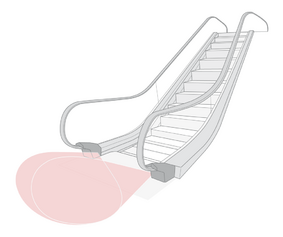
Section 120.6(g) applies to nonresidential new construction escalators and moving walkways in airports, hotels, and transportation function areas, as well as existing escalators and moving walkways undergoing major alterations involving mechanical equipment or controls in the same locations. The goal behind this measure is to save energy by reducing the full-speed run time of the escalator by slowing it down when unoccupied.
10.11.2.1 Escalator and Moving Walkway Speed Control
Escalators and moving walkways in airports, hotels, and transportation function areas shall automatically slow to the minimum permitted speed in accordance with ASME A17.1/CSA B44 when not conveying passengers.
The ASME A17.1/CSA B44 2013 requirements for intermittent speed control on escalators and moving walkways are summarized below. These requirements are necessary to ensure maximum passenger safety when speeding up or slowing down escalators and moving walkways. To comply with the Energy Standards, the escalator or moving walkway must also comply with ASME A17.1/CSA B44 2013. Additional safety requirements may exist in Title 8.
Variation of the escalator and moving walkway speed after start-up shall be permitted provided the escalator and moving walkway installation conforms to all of the following:
1. The acceleration and deceleration rates shall not exceed 0.3 m/s² (1.0 ft/s²).
2. The rated speed is not exceeded.
3. The minimum speed shall be not less than 0.05 m/s (10 ft/min).
4. The speed shall not automatically vary during inspection operation.
5. Passenger detection means shall be provided at both landings of the escalator such that:
a. Detection of any approaching passenger shall cause the escalator or moving walkway to accelerate to, or maintain the, full speed conforming to (1) through (4) above.
b. Detection of any approaching passenger shall occur sufficiently in advance of boarding to cause the escalator or moving walkway to attain full operating speed before a passenger walking at normal speed [1.35 m/s (270 fpm)] reaches the combplate.
c. Passenger detection means shall remain active at the egress landing to detect any passenger approaching against the direction of escalator or moving walkway travel and shall cause the escalator or moving walkway to accelerate to full rated speed and sound the alarm at the approaching landing before the passenger reaches the combplate.
6. Automatic deceleration shall not occur before a specific period of time has elapsed since the last passenger detection that is greater than three times the amount of time necessary to transfer a passenger between landings.
7. Means shall be provided to detect failure of the passenger detection means and shall cause the escalator or moving walkway to operate at full rated speed only.
Figure 10-44: Example of Pedestrian Detection Method Using Motion Sensors

Source: wwwtelcosensors.com/solutions/industries/elevators
From 6.1.4.1 of ASME A17.1-2013/CSA B44-13, the maximum speed of escalators cannot be more than 0.5 m/s (100 ft/min), measured along the centerline of the steps in the direction of travel.
From 6.2.4.1 of ASME A17.1-2013/CSA B44-13 the maximum speed of a moving walkway depends on the maximum slope at any point on the treadway as listed below:
1. Max slope of 0-8 degrees: 0.9 m/s (180 ft/min)
2. Max slope above 8 & less than 12 degrees: 0.7 m/s (140 ft/min)
Escalator speed control is required only in airports, hotels, and transportation function areas. A transportation function area is defined in §100.1 of the Energy Standards as the ticketing area, waiting area, baggage handling areas, concourse, in an airport terminal, bus or rail terminal or station, subway or transit station, or a marine terminal. The reason behind limiting the scope of this measure was to focus on escalators and moving walkways that experience pedestrian flow rates in waves and are more likely to operate 24 hours a day. An escalator in a busy shopping mall that operates only 12 hours a day may experience a constant pedestrian flow rate throughout the day and would rarely slow down and, therefore, save little energy. For these continuously busy applications during the operating hours of the escalator, the speed control would not be cost-effective.
There are no prescriptive measures for escalators or moving walkways.
•An escalator or moving walkway installation is considered an addition when the location of the installation did not previously contain an escalator.
•An alteration is a change to an existing escalator or moving walkway system that is not an addition or repair. An alteration could include installing new controls or motor.
•A repair is the reconstruction or renewal of any part of an existing escalator or moving walkway system for maintenance. For example, a repair could include the replacement of a damaged step or handrail.
Any addition or altered space must meet all applicable mandatory requirements. Repairs must not increase the preexisting energy consumption of the repaired component, system, or equipment; otherwise, it is considered to be an alteration.